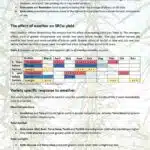Willow
Salix spp.
General info
Willow is one of the most popular short rotation coppicing species for energy crop utilisation, it is a pioneer species that establishes well in new environments with rigorous juvenile growth. It comprises over 400 species worldwide with around 10% of these being deciduous tree species and most being multiple stemmed trees and shrubs.
Due to popularity and success, there are >50 willow cultivars registered with the Community Plant Variety Office (CPVO) with more the 25 commercially available in the UK. Commercial varieties provide benefits including increased rust resistances and increased yields compared to wild varieties due to targeted enhancements. Key willow species for bio-energy production in the UK tend to originate from northern temperate species as they can largely deal with the range of temperatures faced in the UK.
Cultivation and agronomy
Willow can be harvested on 2–5-year rotations at densities up to 15,000 plants per hectare depending on the productivity of the site and the environmental conditions. Planted willow can remain viable for 15–30 years and has a rapid growth rate achieving 6–8 metre heights between each rotation of cutting (depending on rotation year strategy employed).
Generally, willow is adaptable to a range of soils and conditions, however dry sandy soils may struggle to supply sufficient moisture for efficient growth, and organic peat heavy soils may cause too much competitive weed impacts to make the growth strategy efficient. Willow coppices need more water than any other conventional agricultural crop therefore areas of high rainfall are extremely beneficial.
Despite the temperate adaptability of most willow species for higher productivity rates it is recommended that plantation sites be below 100m above sea level. It has been shown that Willow harvesting yields equated to 5–14 oven dried tonnes ha-1 y-1 across several studies, with 1 hectare supply of willow woodchip providing energy roughly equivalent 4,500 litres of home heating oil (depending on moisture levels of willow biomass and productivity of a given hectare per year etc).
Commercially, willow propagation involves the planting of winter-dormant stem cuttings in the spring. Mechanical planting is performed whereby cut stem sections from willow whips are inserted into prepared soils. Following the first growing season cutbacks are performed to around 10cm above ground level to encourage the formation of multi stemmed stools for increased productivity benefits.
Return to crops overview
Relevant research
Clifton‐Brown, J., Harfouche, A., Casler, M. D., Dylan Jones, H., Macalpine, W. J., Murphy‐Bokern, D., … & Lewandowski, I. (2019). Breeding progress and preparedness for mass‐scale deployment of perennial lignocellulosic biomass crops switchgrass, miscanthus, willow and poplar. Gcb Bioenergy, 11(1), 118-151.
Biomass Connect Trials
SRC willow is currently being grown as part of the Biomass Connect trials at the following hub sites:
- AFBI Hillsborough
- BGI Chesham
- IBERS Aberystwyth
- NIAB Headley Hall
- Newcastle University Cockle Park Farm
- Rothamsted Research North Wyke
- SRUC Ayrshire
- SRUC Edinburgh
We also have a willow varieties trail at the following hub sites:
Additional Resources from Biomass Connect
Read our Willow Factsheet
More Resources

Read the growers guide to short rotation coppice willow varieties for biomass publication from the AWBD Project.





